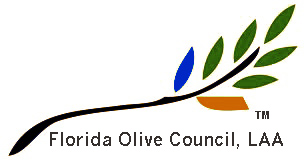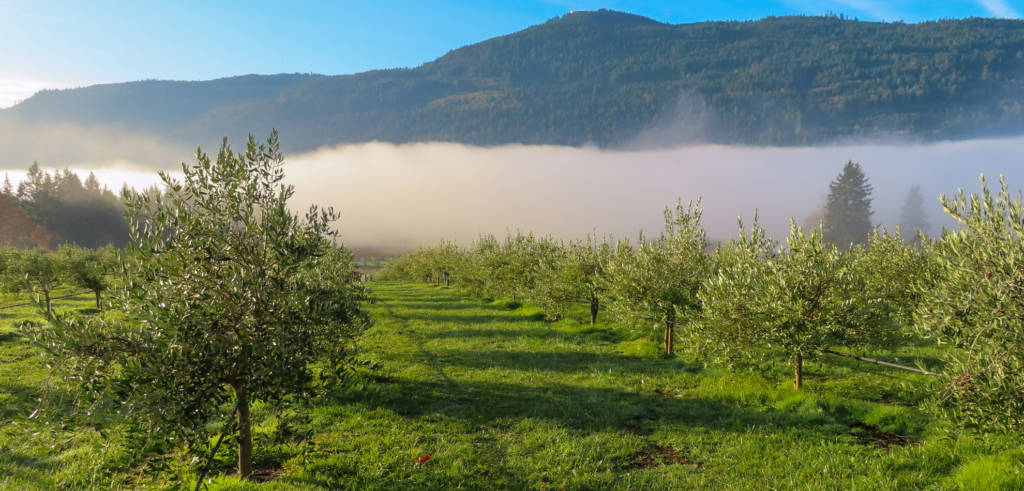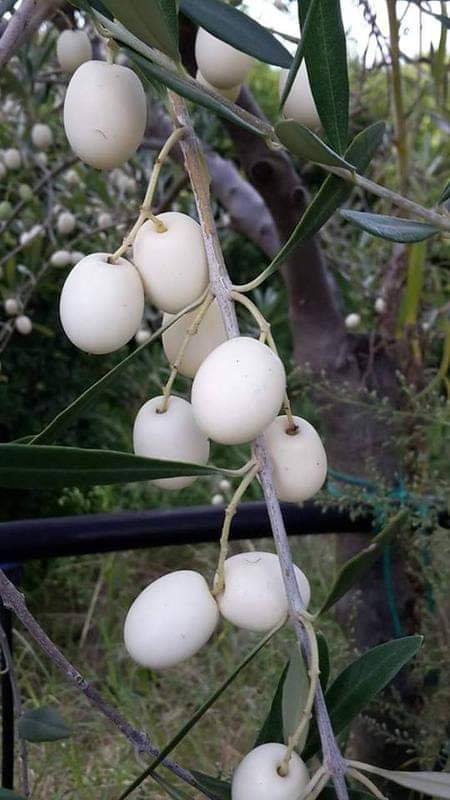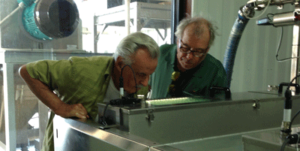HOT NEWS!!!!
Click HERE for link to excellent site on growing food crops in Florida
Click HERE for story on Low Chill Olive research in Canary Islands
Click HERE for story on Low Chill Olive research in Peru.
Click HERE for information on FREEZE damage on olive trees
Click HERE for tour of Florida olive grove north of Tampa
Click HERE for UF-IFAS video on current olive research in Florida.
Click HERE for Olive Bud Dormancy Release Dynamics Paper from University of Cordoba Spain
Chick HERE for UF-IFAS Press Release on Olive Research project
Click HERE for story on Collapse of Spanish Olive Crop 2022
Click HERE for International Olive Growing Compendium
Click HERE for good research paper on olive flowering in lower latitudes.
Click HERE for CA Olive Crop – Significant Drop in 2022-23 production
Click HERE for Research Paper – USF – Sustainable Practices for Olive Cultivation in Florida.
Click HERE for July 2022 Florida “Low Chill” olive research report.
Click HERE for SPRING 2021 Florida Olive Report.
Click HERE for SPRING 2022 Low Chill Florida Olive Report.
Click HERE for FALL 2021 Florida Olive Report.
Click HERE to listen to Dr. Kevin Folta’s (UF/IFAS) podcast with Dr. Lorenzo Leon a noted Spanish olive researcher.
Click HERE to download the 2021 Guide to Growing Olives in Florida.
The Olive
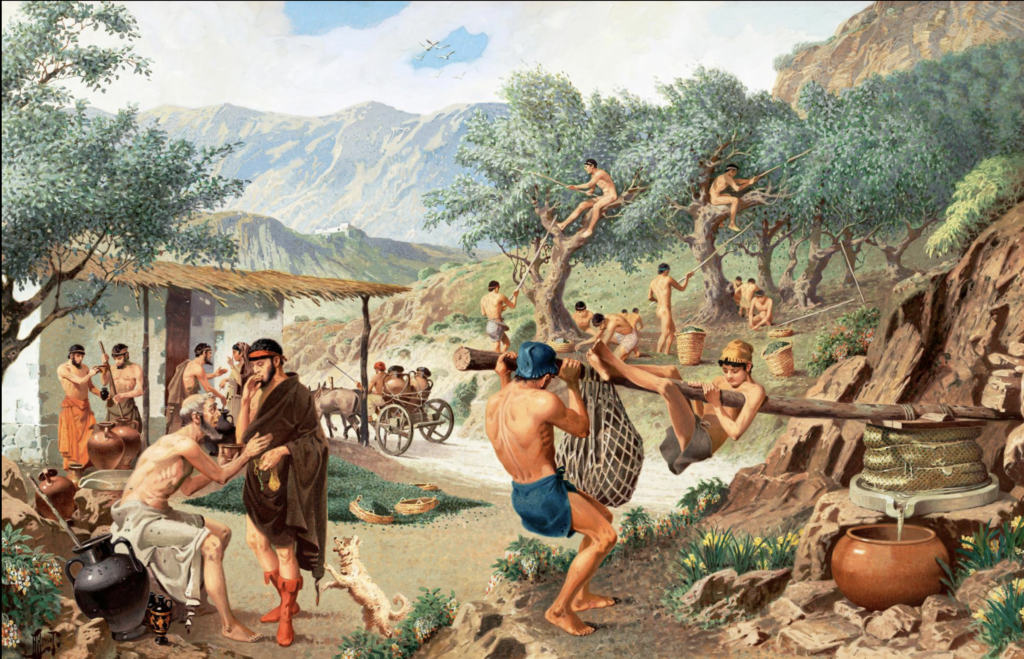
Early Romans Harvest and Press Olive Oil
The olive (Olea europaea L.) is the oldest known cultivated crop. Originating in the deserts of the Middle East, olives are grown from the warm Andalusian plains of southern Spain to the chilly Himalayan hillsides of Nepal. Carbon-fiber evidence suggests olives were consumed near the Mediterranean coast 10,000 years ago. Today there are 2000 named olive cultivars and more new varieties in development. In 2016, a crucial scientific threashold was crossed when Spain documented the olive genome using a 1300 year old Fargo olive tree. Spanish agricultural scientiests developed new varieties like cv. Arbequina and cv. Chiquitita to enable high-density planting and mechanical harvesting. Other varieties are developed for resistance to disease and drought. The climatic adaptability of the olive is obvious as it is grown in over 30 countries. Today the Florida Olive Council is searching for a low chill olive cultivar for Florida. Such a cultivar could render acres of now-fallow citrus land productive again and create a multi-million dollar industry.
Search for a “Low Chill” olive variety
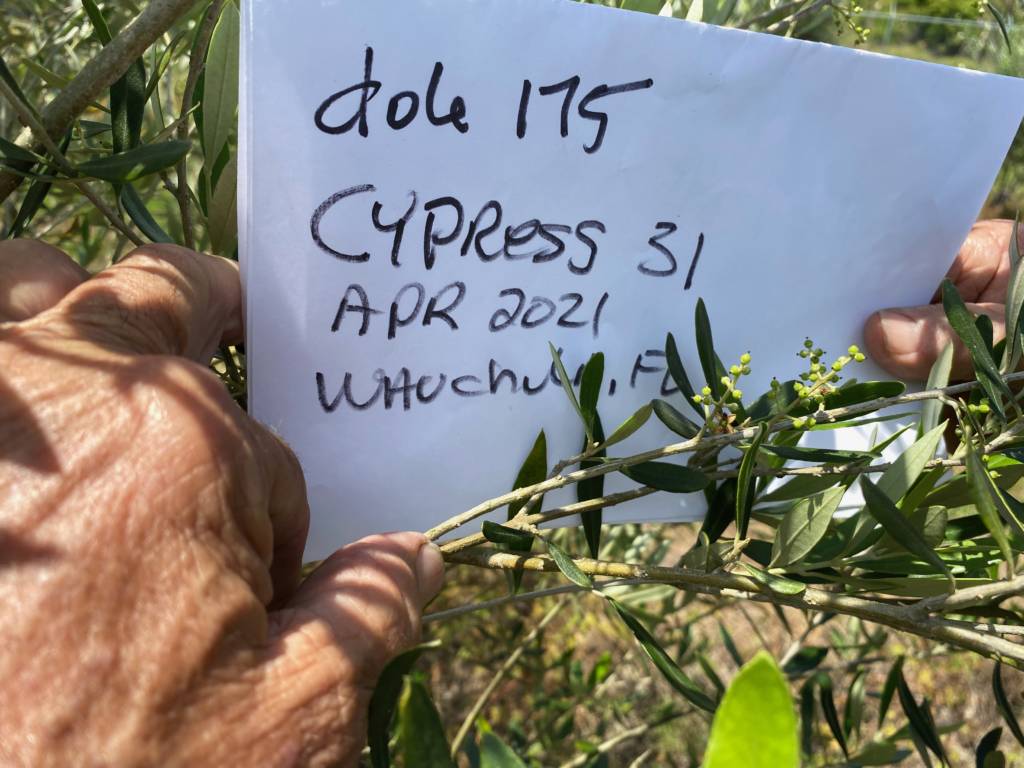
Since 2011, the Florida Olive Council, LAA has partnered with public and private organizations conducting olive research statewide. Multi-variety test plots were installed at five (5) UF-IFAS Research and Education Centers, Hardee County Industrial Development Authority in Wauchula, Mosaic Corporation in Bowling Green, Lykes Brothers in Lake Wales and many others. The majority of cultivars planted in those test plots were sourced from California nursery stock adapted to a northern Mediterranean climate (Spain, Italy, Greece) at 38-41°N Latitude.
Olive growing areas of California are on a similar latitude with the northern Mediterranean basin. While these northern Mediterranean varieties (NoMed) can flower and fruit in northern areas of Florida where annual chill exceeds 300 hours; they struggle south of the I-4 corridor (28°N. latitude) where chill-hour* accumulation is 100-120 hours.
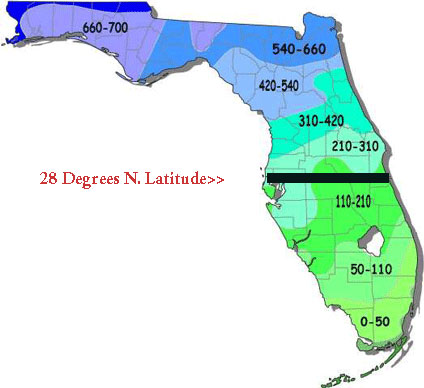
Florida Chill Hour Map
Since the five SW Florida counties: DeSoto, Polk, Hendry, Highlands and Hardee account for 66% of all citrus acreage in Florida and have suffered significantly with HLB or fatal greening disease, this area is the focus of the Council’s low-chill olive research initiative. With over 250,000 acres of fallow grove land, an alternative cash crop with returns like citrus ($2,000-$3,000/acre) is critical. As well, any crop planted to supplement citrus should be able use the citrus industry packing and transportation infrastructure with minimum retooling and capital outlay.
(*One chill hour = 1 hour between 32°-45°F or 0° – 7.2° C)
Current Florida Olive Council research is focused on identifying olive cultivars growing in regions near lower latitudes. These regions include the Middle East and North Africa (MENA), South America and Southern Australia. In 2017-2018, the Council secured 45 candidate low chill varieties native to these regions. The cuttings were provided by the USDA Germplasm at University of California (Davis) to ensure true-to-type genetic documentation.
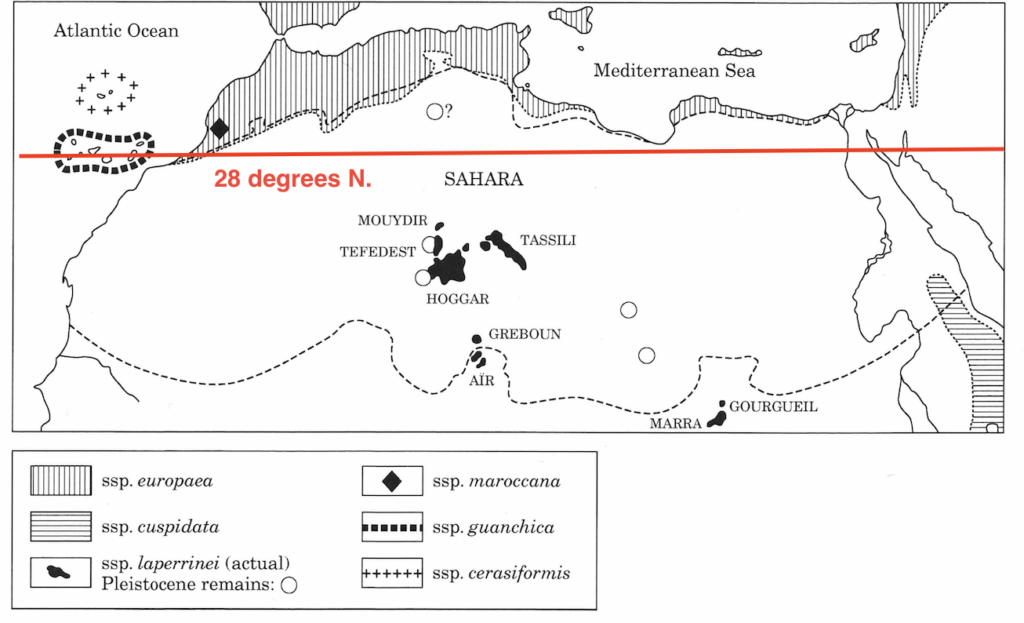
Southern Morocco
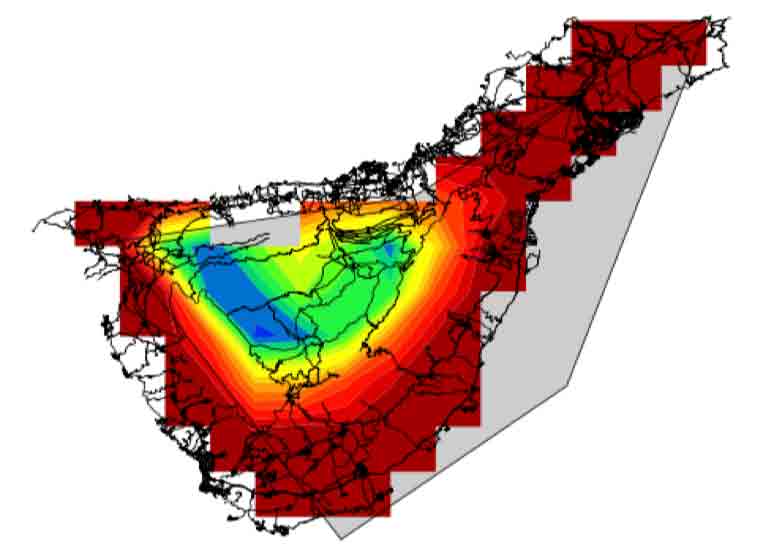
Satellite Heat Map (Courtesy of Blue Skies)
Due to a lower chilling requirement, researchers postulate olive cultivars from southern latitudes might be better suited to produce in SW Florida . However, since some cultivars require 4-7 years to flower and fruit, the research team grafted the candidate varieties onto mature (4+ year-old) Arbequina olive trees in hopes the mature rootstock would short cut the maturity time and induce early flowering on the graft. Over 400 grafts are installed at the Hardee County research facility in Wauchula, FL. Researchers are hopeful to see the first flowering in 2021. Cuttings from these candidate varieties are also rooted the Council research facility near Gainesville.
To further the research, the Council is partnered with the Moroccan Université Abdelmalek Essaâdi and the Spanish Jefa del Servicio Técnico de Granja Agrícola Experimental to conduct field experiments in Las Palmas/Tenerife in the Canary Islands (Spain) and the Souss Valley near Agadir, Morocco. These areas are located in close proximity to 28°N. latitude and have a long history of olive production. In order to find cultivars that are producing in desired chill-hour accumulation area, the Council will use satellite data to determine which areas have historic chill accumulation in the 60-210 hour range and then conduct field experiments to identify the trees, investigate yield, cultivation practices and collect other data. There are several older and more rare varieties of olive in this region (e.g., ssp. maroccana and ssp.guanchica) that are of particular interest. These varieties have survived and produced over centuries but have fallen out of favor due to size of fruit and other factors. However, they might provide the genetic material necessary to enable development of a low chill variety that will prove to be a reliable cash crop for SW Florida farmers. Field work in Spain and Morocco has been temporarily suspended due to COVID pandemic. However, desk research and cultivation of existing 45 candidate varieties continues.
With just over 10,000 people, the island is known for its artists and the unique climate that encourages the cultivation of totally organic and local produce that is displayed at the farmers’ market every Saturday from April to October each year. Wine, fruits, vegetables, flours, and aromatic plants can be found in this peculiar market, along with another product that is native to the island which has been being sold here for the last several years – Extra Virgin Olive Oil.
The oil comes from the Braun family’s farm. After a visit to Spain they became enamored of the beautiful olive oil and trees of Andalucia. While Salt Spring climate might not support olives the family was willing to try. They bought Maurino variety plants in California and started their dream. At the beginning, they planted nearly 1000 olive trees on the slopes of the Fulford Valley. The inclement weather, with dry summers and cold winter proved not to be too much for the plants, nor did the unexpected visits from deer feasting on their fruit.
In spite of everything, after harvesting their first crop of olives, this family decided to bet on this southern Iberian dream. Therefore, they planted another 1500 olive trees that shared land with blueberries, grapes, kale, garlic and some other cereals like wheat.
Today these truly unique olive trees, cultivated outside their “comfort zone” are now in production. They produce an oil with intense, yet balanced fruitiness with notes of green almond, artichoke and fresh-cut grass. The harvest must be early, so that the possible frosts at the end of autumn do not affect the harvest. The Braun family are true American olive pioneers.
Courtesy: Juan Vilar, Strategic Consultants
4000 Acres of Olives Planted 40 Miles North of Tallahassee
Agrigrada, a Swiss corporation, planted a 4,000 acre olive grove near Colquitt, GA, approximately 40 miles north of Tallahassee, FL. The grove was established in 2017 and suffered some damage from Hurricane Michael.

Aurelien Rifaut, Co-Founder and Director of Agrigrada (pictured) has repaired damaged areas of the grove and expects to harvest his first crop in two years. The high-density grove includes Arbequina, Koroneiki and a new Leccino-Arbequina cross provided by Agromillora, a large Spanish firm.
Girdling to Encourage Blooming in Olive
When olives are stressed they try to procreate. Girdling, a process of stripping the bark from a branch, has proven to be a method to encourage blooming and fruit set in olive. In the photo below, an Arbequina olive tree growing behind Viola’s Restaurant in St. Augustine, FL is stressed by rubbing on a pergola. You can see the intense blooming and fruit set on the branch. Branches on the tree that were not girdled produced far fewer fruits. In the 1950s, Professors H.T. Hartmann and R.M. Hoffman conducted field studies to determine how girdling promoted blooming in olive. Click HERE for the report.

Girdled olive branch producing st augustine
Careful Using Herbicides Near Olive Trees
Glyphosate and some other herbicides are injurious to olive trees. While herbicides will not generally harm mature olive trees; application of herbicides when trees are small (<2 years) can cause signifcant damage and even death. In the photo at left, a “pre-emergent” herbicide commonly used in Florida citrus groves has systemic impact on a 3 year old cv. Arbequina.
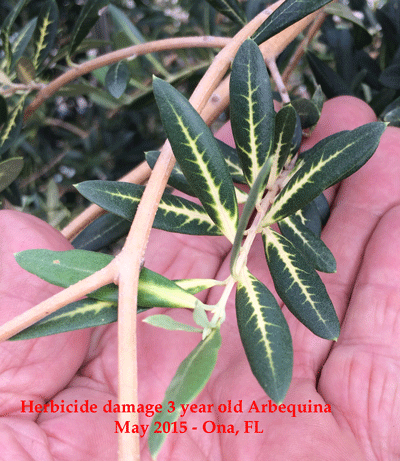 While not killing a mature tree, some herbicides and particularly those not applied correctly, can reduce the tree’s ability to uptake nutrients. Before applying herbicides near your olive trees contact your supplier and find out if the product is safe for olive (Olea europaea L.). The image at right was taken at a citrus grove recently treated with a pre-emergence herbicide. Not the unique leaf coloration indicative of glycophosphate contamination.
While not killing a mature tree, some herbicides and particularly those not applied correctly, can reduce the tree’s ability to uptake nutrients. Before applying herbicides near your olive trees contact your supplier and find out if the product is safe for olive (Olea europaea L.). The image at right was taken at a citrus grove recently treated with a pre-emergence herbicide. Not the unique leaf coloration indicative of glycophosphate contamination.
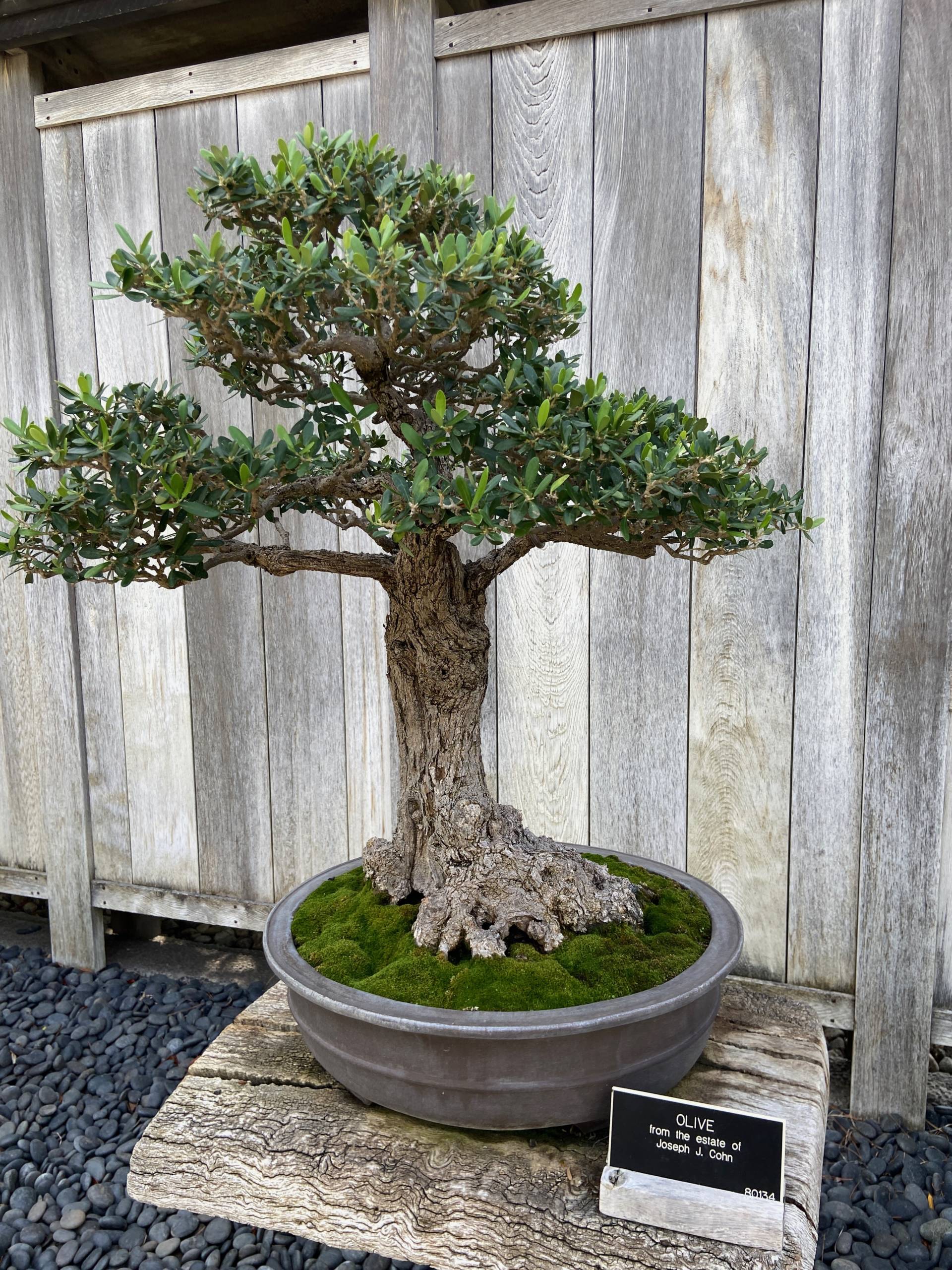
Olive Bonsai at The Huntington Botanical Garden near Los Angeles
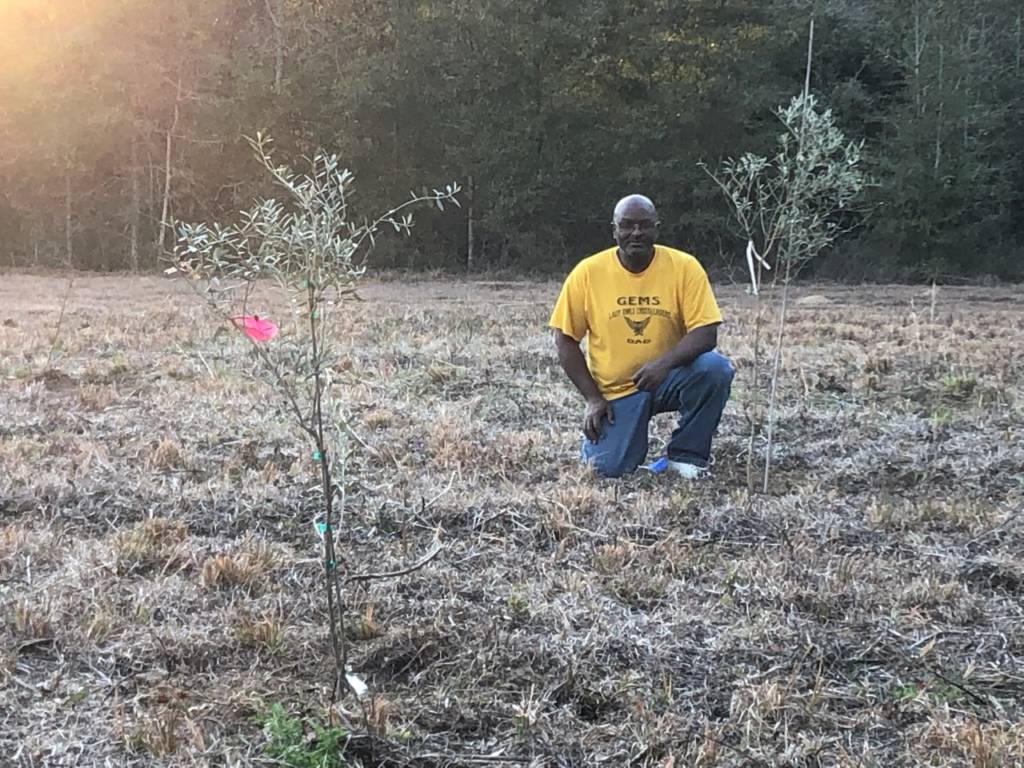
Quincy farmer Donnie Washington is partnering with the Florida Olive Council and Florida A&M University to research olive growing in the Florida Panhandle. The project will evaluate six varieties: Empeltre, Manzanilla, Taggiasica, Coratina, Hojiblanca and Oliana.
Florida Olive Council Featured Vendor
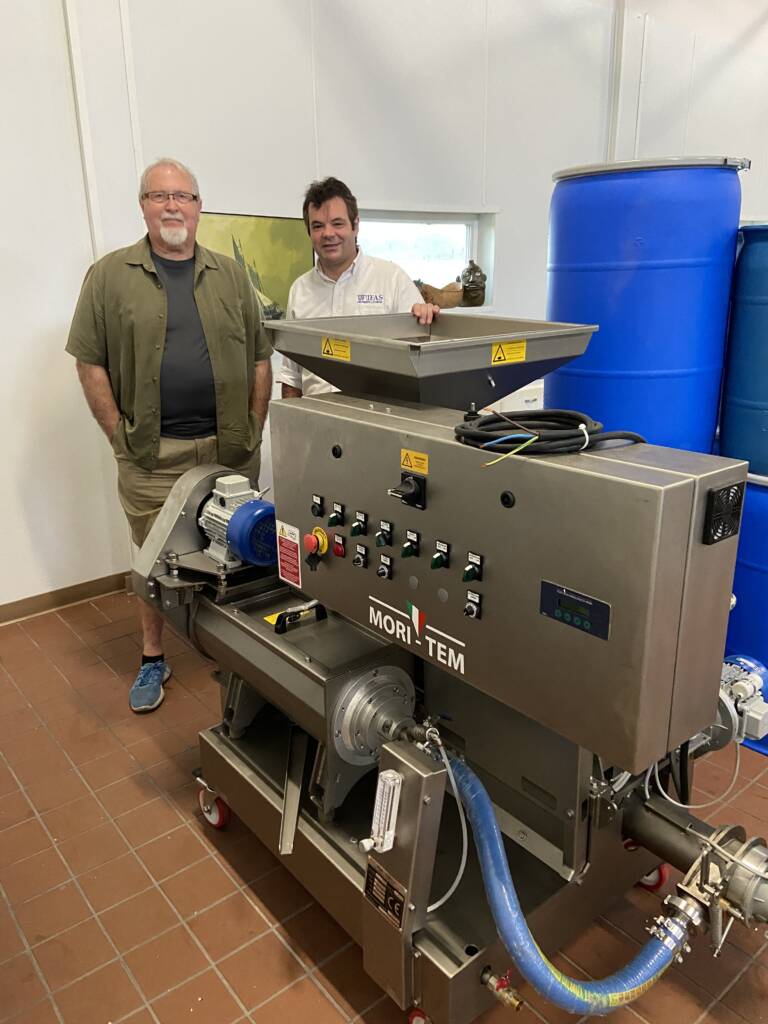
l-r Mike Thomas, Dr. Lorenzo Rossi, UF-IFAS Olive Research
Blackwater Olive Mill
Blackwater olive grove was established in 2014 across from the University of Florida’s Agricultural Research and Education Center at Jay, FL. In addition to 14 acres of olives, owner Mike Thomas has installed a two stage OlioMio olive mill and will provide milling services for Florida olive growers. Contact Mike Thomas (850) 380-8765. 4470 CR 182 Jay FL 32565
President’s Box
Future Florida Agriculture
Shall we continue 19thcentury agriculture practices, feeding more water and chemicals into market-marginalized, disease-prone mono-cultures; or embrace a 21stcentury paradigm of nature-considerate, cultivar-diverse cash crops selling profitably into expanding global markets accessed at light speed?
Does anyone really think the citrus industry will return to pre-2000 levels? How long will big agriculture’s nitrogen effluent and deadly algae blooms, be sustainable? Can family-owned timber and cow-calf operations withstand the pressure of urban encroachment? From the Capitol dome in Tallahassee to the tractor cab in Immokalee; Florida agriculture needs new ideas and new leadership.
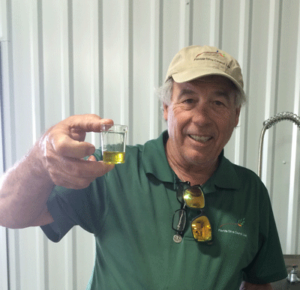
Michael O’Hara Garcia
We need an informed, transformative approach. We must leverage our first-on-market natural geographic advantage. We must encourage our brilliant agricultural scientists as they develop high-value crops with global demand. Government must facilitate this transformation with logical water and land use policies and an aggressive multi-platform marketing campaign linking customers and farmers.
Let Florida take the lead and set an example for the nation creating an environmentally-considerate and crop-diverse agriculture that will sustain our farm families into the next century.
NEWS FLASH: The American Association of Olive Oil Producers (AOOPA) petitioned the U.S. Federal Drug Administration (11/5/2019) to develop and enforce standards of olive oil quality. If the regulations are approved, truth–in-labeling will be required. This will ensure consumers are protected from unscrupulous vendors. Click for copy of petition. Click for copy of news story.
WHITE OLIVE
The white olive tree (Leucolea) dates from ancient Greece.
The white olive was cultivated during the time of Magna Grecia. It spread throughout the region of Calabria, especially near the royal monasteries. The fruit was called “leucolea” which means white olive, due to its characteristic color, which remains white even when they reach full maturity.
These olives produce a pure oil once called olio del crisma “the oil of Christ”, which was used to anoint the Byzantine emperors, those who are appointed to high positions, and especially as a sacred oil in religious services, such as: baptism, anointing of the sick, ordination of priests and bishops. This oil was also used to power the lamps in the sanctuaries because it produces little smoke during combustion.
For this reason the monks cultivated carefully and took care of the rare white olive tree, near the Monasteries. With the spread of royal monasticism in southern Italy, between the seventh and tenth centuries, white olive cultivation received a significant boost.
Today modern Italian growers are reviving this rare species especially in Calabria – in the countryside of Nova Siri (Matera), in the areas of Pizzarello and Pietrosa in the Leukocarpa valley. Scientifically, olive fruits cannot synthesize anthocyanins and therefore take on a color similar to ivory.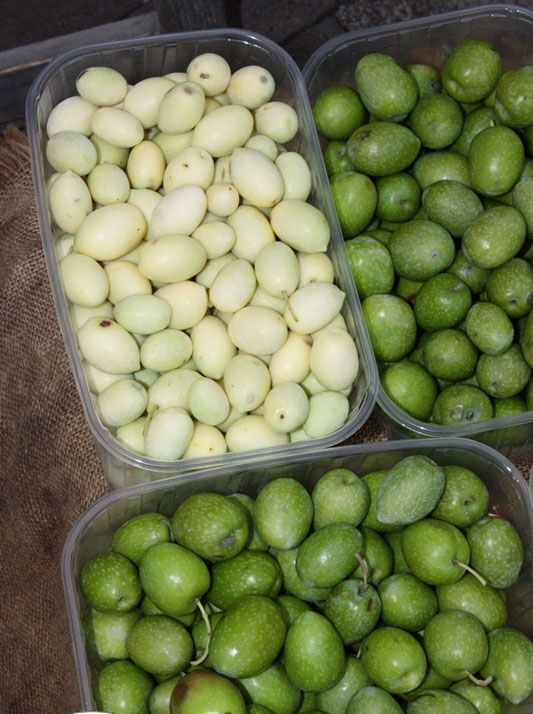
Today, two young Italian producers, Antonio Manolio and Carlo Stigliano, intend to start a search for the Leucocarpa plains in Basilicata, and make a morphological comparison of fruits and leaves found in the area. Symbolically the area was renamed by the two new producers as “White Magna Grecia” and can become a symbol of the important cultural heritage of biodiversity.
Basic Olive Cultivation
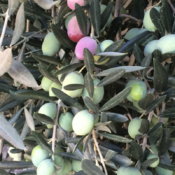
The olive (Olea europaea L.) has been cultivated in Florida for over 400 years and currently there are several producing olive groves in the State. However, Florida olive cultivation is still in the experimental stage-more research is needed. If you are considering planting olives in Florida as a hobby or a commercial enterprise, we suggest you start with this section.
Media
In this section find the latest domestic and international olive news, olive research, current market conditions, political and regulatory environments, olive oil consumption and quality and social media content.
In addition, this section has links to health-related news on olives and olive products, Power-Point presentations on olives, YouTube “How To” videos, and other video segments on olive cultivation, harvesting, milling, and marketing.
Grower’s Forum
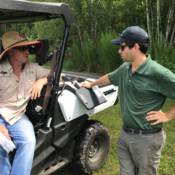
Here Grower-Members can find access to information from olive growers in Florida and internationally. The forum discusses topics like soils, irrigation, pests and production; or start your own discussion thread. The Grower’s Forum also includes links to the Florida Olive Research Database and periodic reports on the progress of field trials and cooperative research.
Research
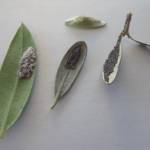
The Research Library is a good starting point for Grower-Members to learn more about olives. The library contains hundreds of research reports, U-Tube Videos, government documents and foreign publications on olive history, cultivation practices, genetics, disease, reproduction, economics, olive oil chemistry, Florida cultivation and other topics.
FLORIDA OLIVE PIONEERS
Don Mueller
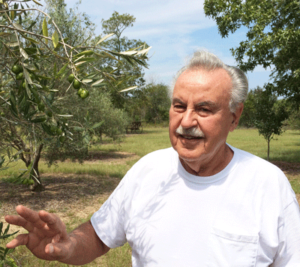
Don Mueller, Godfather of Florida Olives
Don Mueller is The Godfather of Florida Olives. Don and his wife Jan discovered olives during a trip to Italy staying at a rural guest house located next to a producing olive grove. Inspired, Don studied olive production and various aspects of olive cultivation and found varieties that would produce in Florida’s panhandle. He planted what has become the oldest consistently producing olive grove in Florida featuring several varieties of Italian, Greek and Spanish olives.
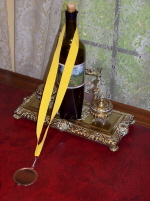 He began installing trees on a five acre plot near Compass Lake (Astor/Marianna) in 1999. As the olive trees took hold, in the red clay of Jackson County they began to flower and produce beautiful fat olives. Don, an engineer by training, then set up a home olive processing line, made olive oil and brined olives. The Greengate Olive Grove has been producing olives and olive oil for the past 15 years.
He began installing trees on a five acre plot near Compass Lake (Astor/Marianna) in 1999. As the olive trees took hold, in the red clay of Jackson County they began to flower and produce beautiful fat olives. Don, an engineer by training, then set up a home olive processing line, made olive oil and brined olives. The Greengate Olive Grove has been producing olives and olive oil for the past 15 years.
Don won a gold medal at an international olive oil competition and has bottled olive oil and produced olives for U-pick operations that take place every year around October. Olive lovers travel hundreds of miles to sample Don’s unique crop. After 20 years of hard work and determination Don has developed a beautiful olive grove. In 2017, Sally and David Gist purchased Don’s grove and continue to lovingly care for the olive trees. The grove hosts a U-pick opportunity in the Fall. Pick your own olives for table or oil.
Contact Don: olivegodfather@gmail.com
William (Bill) Lambert
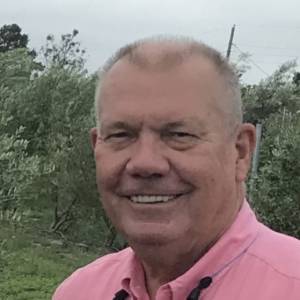
Bill Lambert, Hardee County Economic Development Authority
Bill Lambert, Executive Director of the Hardee County Industrial Development Authority, is one of the true Florida agricultural pioneers. A life-long resident of Hardee County, Bill watched as HLB disease devastated his neighbor’s citrus groves. The situation went from bad to worse.
In 2000, agriculture (primarily citrus) accounted for 33% of Hardee County’s GDP; by 2016 agriculture represented only 18%. USDA says 3,000 acres of citrus groves are abandoned in Hardee County (2017). Bill realized research to find a solution to HLB must continue; but he also felt having a back-up plan was a prudent idea.
In 2016, Lambert approached the Florida Olive Council and the University of Florida Institute of Food and Agricultural Sciences (UF/IFAS) Department of Horticulture to explore new or Pioneer crops. In partnership with the Florida Olive Council, Lambert helped fund the Pioneer Plant Lab at UF-IFAS for the study of new alternative crops for Florida. Lambert and his team also cleared 20 acres of abandoned orange grove near Wauchula and planted several hundred Olive trees, Pongamia, Turmeric, Hops and other experimental crops.
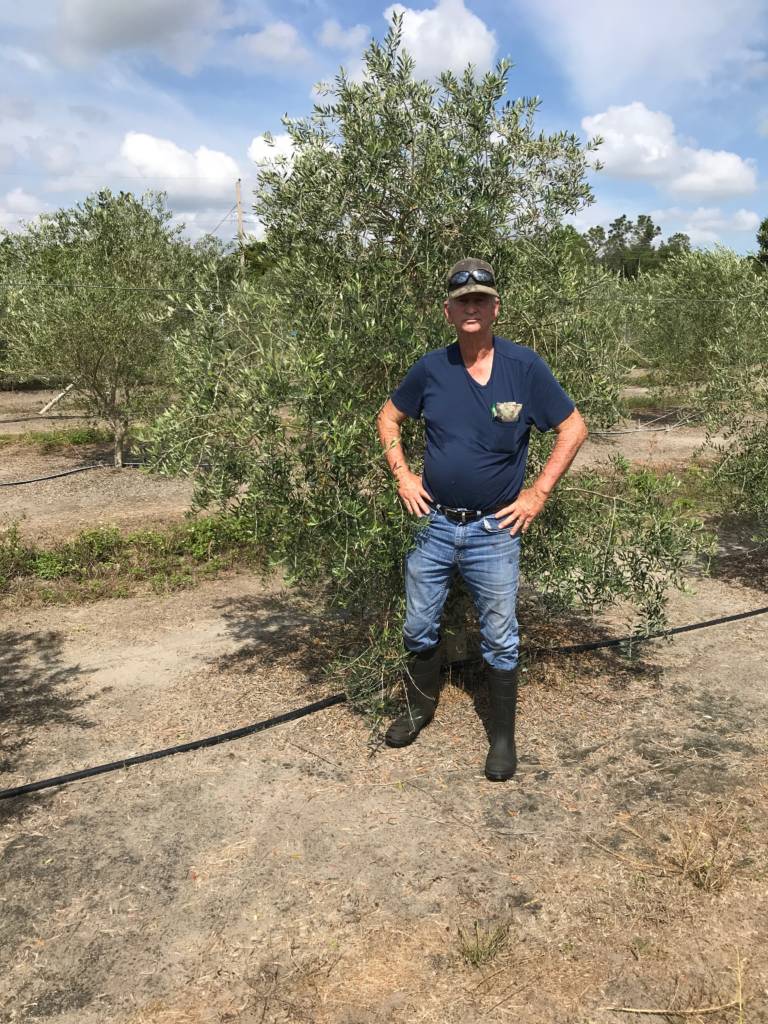
Myles Albritton, Hardee Grove Manager standing in front of a 2 year old Chiquita olive tree.
Tom Oleson
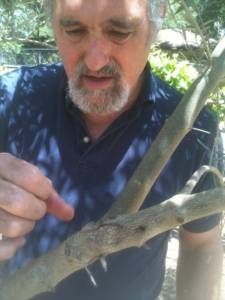
Tom Oleson, Florida Olive Pioneer
Tom “Oliveson” Olsen is another of Florida’s distinguished olive pioneers. Tom established his small (1 acre) experimental grove 20 years ago near Hastings, FL (St. Johns County). Planted on pine land and close to some low areas, the grove had many challenges over the years.
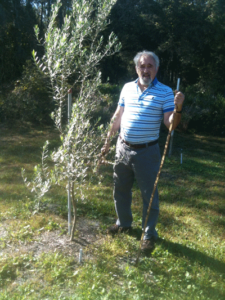
Measuring Ground Water
Tom is probably one one of the top grower experts on disease and environment elements affecting olive trees in Florida and has learned some of the secrets of olive growing in Florida. For example, Tom has a groundwater measurement well dug so he can determine if his olive tree roots will be stressed after a hard rain elevates the water table.
Tom has installed a fertigation system of his own design and reports good growth on most of his trees. He has had various encounters with glassy-winged sharpshooters, stink bugs and deer. Tom has a championed the Chemlali variety with outstanding results and continues to experiment with several other varieties that will adapt well to the climate and soils in northeast Florida.
Contact Tom at: shipscarver@hotmail.com
Alex Ford and Richard Williams
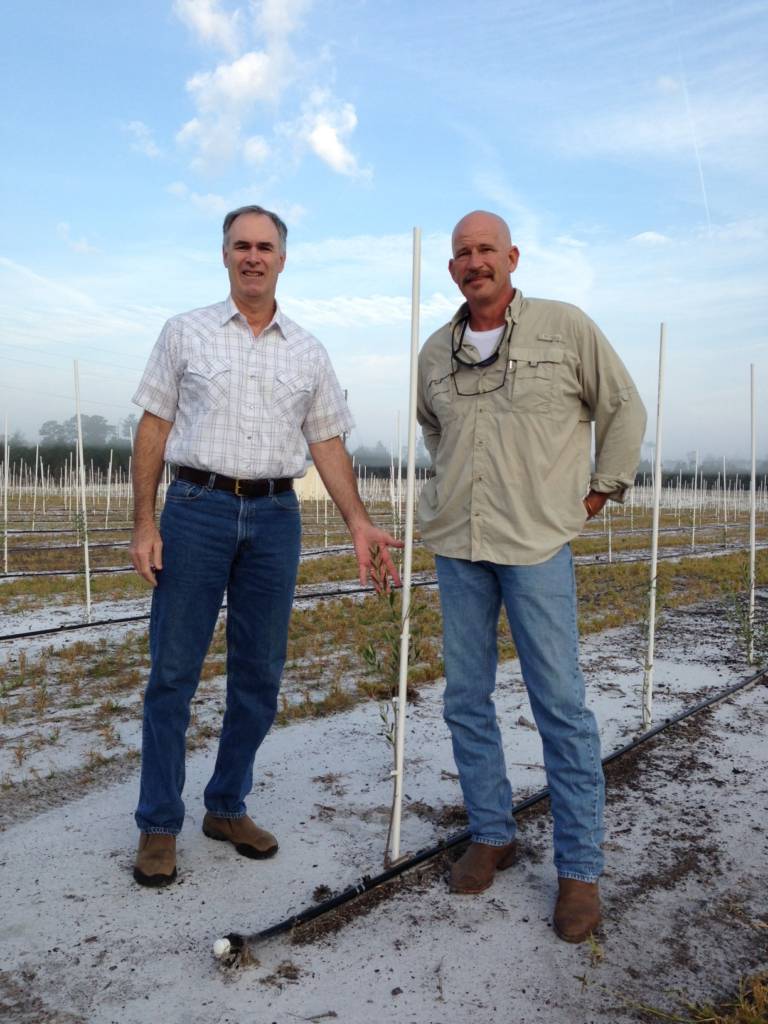
Alex Ford & Richard Williams
Alex Ford and Richard Williams are 5th generation Florida farmers. Over the years they have cultivated ferns, citrus and pine trees. In 2010, the partners began to explore the possibility of growing olives on their land near De Leon Springs, FL. After conducting extensive research, they decided to plant a 20 acre high density grove of Arbequina, Arbosona and Koroneiki olive trees on a section of a former pine tree plantation.
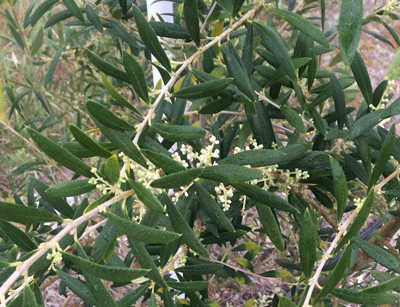
Olives Bloom at Ford-Williams Grove
They harvested their first crop in 2015 and despite setbacks, continue to harvest and press oil for their family and the local market. Chemical analysis of olive oil from the Ford-Williams grove demonstrates extraordinary characteristics and the partners are strong proponents of the healthful qualities of olive oil. They are hopeful they can stimulate interest in olive growing in the area of central Florida where the citrus industry struggles with HLB disease.
Laura Ferman Farrior

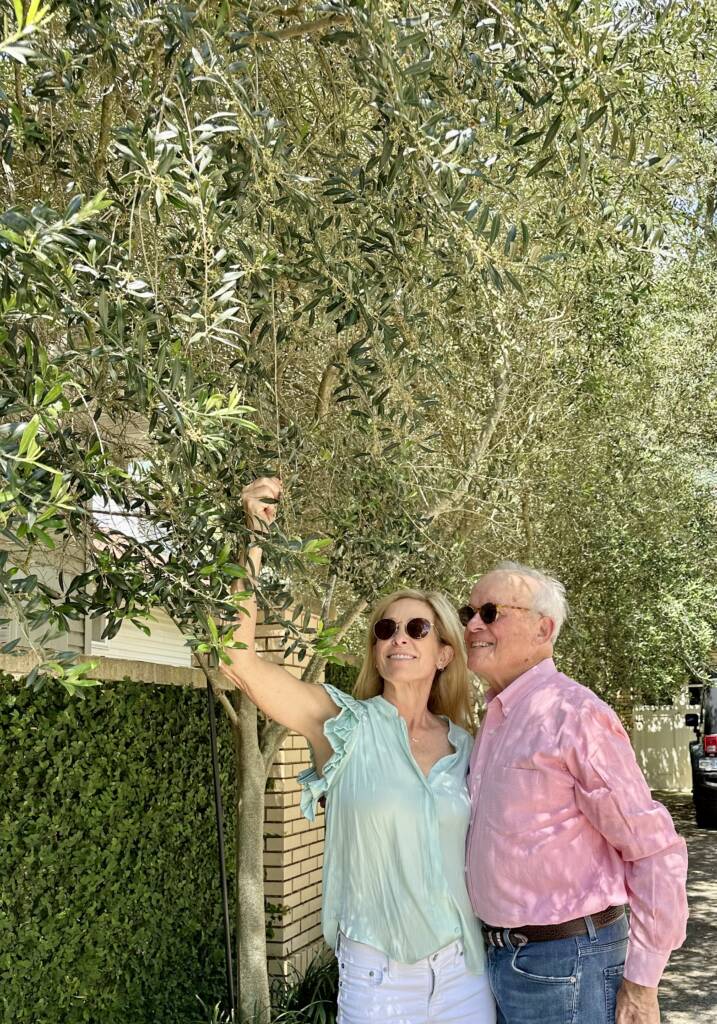 Laura Ferman Farrior is proud of her grove of Arbequina olive trees next to her beautiful home on Bayshore Blvd. in Tampa, Florida. Laura installed the trees, purchased from Sun City Tree Farm (Ruskin, FL) and they have been producing almost every year since. Laura brines the olives and presents them as much appreciated gifts during the holidays and special occasions. James Ferman (pic), Laura’s father, is one of the founders of the Florida Olive Council.
Laura Ferman Farrior is proud of her grove of Arbequina olive trees next to her beautiful home on Bayshore Blvd. in Tampa, Florida. Laura installed the trees, purchased from Sun City Tree Farm (Ruskin, FL) and they have been producing almost every year since. Laura brines the olives and presents them as much appreciated gifts during the holidays and special occasions. James Ferman (pic), Laura’s father, is one of the founders of the Florida Olive Council.
Mary Tracey
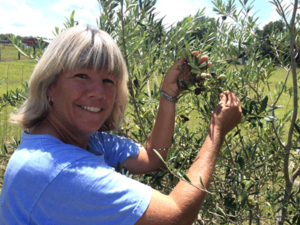
Mary Tracey, Lady Lake, FL
Mary Tracey’s Heather Oaks Farm is an organic farm located near Lady Lake, FL. In addition to blueberries, honey, goats and a host of other beautiful natural foods, the farm hosts several hundred producing olive trees. Mary and her husband Bob planted Arbequina olive trees and have cared for them carefully.
